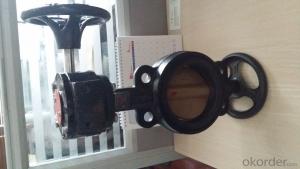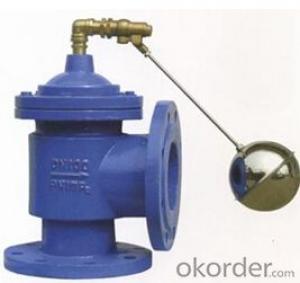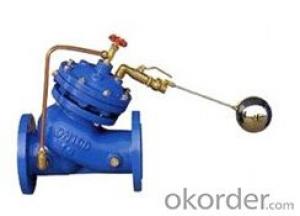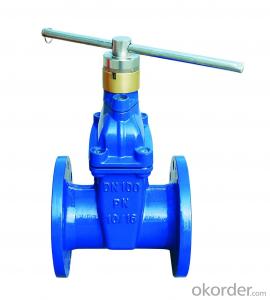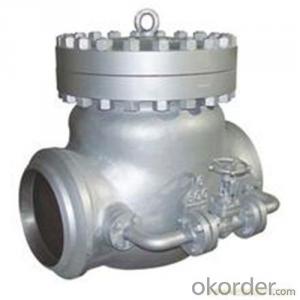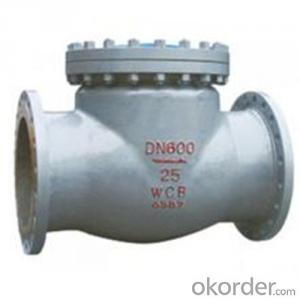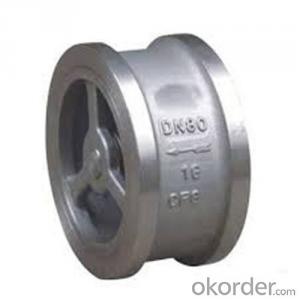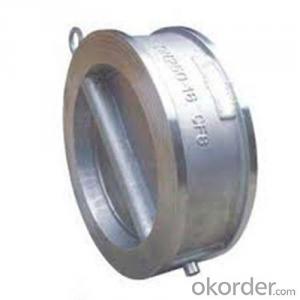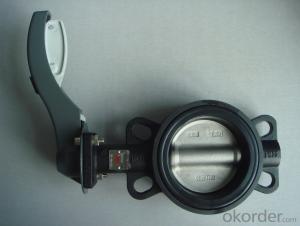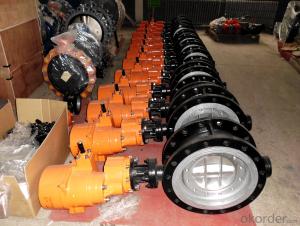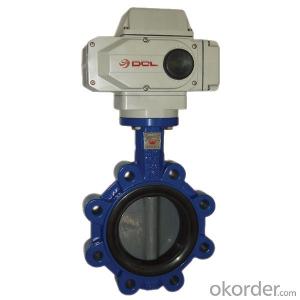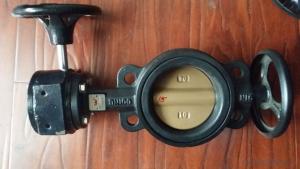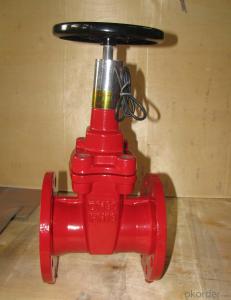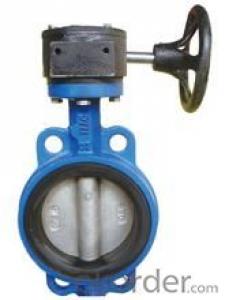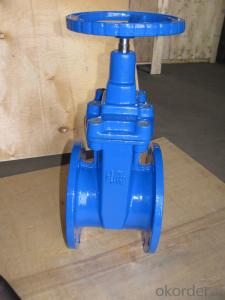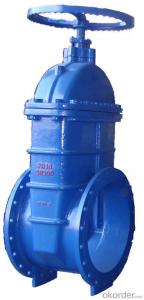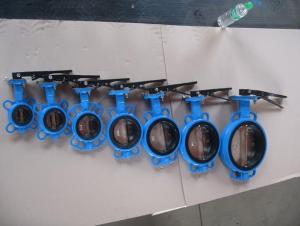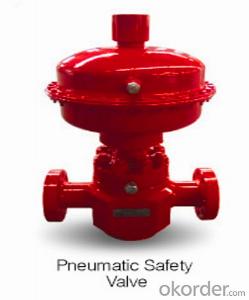Concentric Butterfly Valve ISO5752
- Loading Port:
- China Main Port
- Payment Terms:
- TT OR LC
- Min Order Qty:
- -
- Supply Capability:
- -
OKorder Service Pledge
Quality Product, Order Online Tracking, Timely Delivery
OKorder Financial Service
Credit Rating, Credit Services, Credit Purchasing
You Might Also Like
Features:
1. Small in size, light in weight, easy installation and maintenance.
2. Simple and compact construction, quick 90 degree on-off operation.
3. Minimized operating torque, energy saving.
4. Flow curve tending to straight line, excellent regulation performance.
5. Long service life, standing the test of tens thousands opening/closing operations.
6. BUbbles-tight sealing with no leakage ubder the pressure test.
7. Wide selection of materials, applicable to various medium.
Material List:
| No. | Part Name | Material | ||||||||
| 1 | Body | Carbon Steel/Stainless Steel/Cast Iron/Ductile Iron/ Al-Bronze | ||||||||
| 2 | Disc | Al-Bronze/CF8M/Ductile iron/WCB | ||||||||
| 3 | Seat | EPDM/PEFE/Buna/NBR/Hypalon | ||||||||
| 4 | Stem | Carbon Steel/Stainless Steel314/Stainless Steel316 | ||||||||
| 5 | Bushing | PTFE/Lubricating | ||||||||
| 6 | O ring | EPDM/PEFE/Buna/NBR/Hypalon | ||||||||
| 7 | Pin | SS316/SS416/SS304 | ||||||||
- Q: I have a 1989 Jeep Cherokee with 218,700 miles on it and my engine has thick oily gunk on it, possibly from a leaky valve cover gasket, should I change the gasket? I have been told that this is normal and not to worry about, but from the amount of this gunk, I find it hard to believe this is normal. The top of the valve cover has a light covering of gunk, but on the sides and towards the bottom of the engine. it gets very thick and at some places you can't even make out whats suppose there. Does a leaky valve cover gasket mean that there is another problem going on?Can leaving the oily gunk on the engine cause any problems?Any info would be greatly appreciated.
- Usually, a leaky valve cover gasket is just that. A leaky valve cover gasket. Unless you are building up high internal pressure from a clogged PCV for example and literally forcing the oil out the weakest point, there usually is no underlying issue. Leaving the oily gunk does a couple things. If its on rubber such as any hoses that aren't oil resistant, they will degrade quickly. The same can goes for wiring insulation, motor mounts, or even the rubber seals on some of your front end pieces. Also, wrapping an engine in a thick layer of goo doesn't let it cool as it should and puts more thermal burden on it. What you do at this point is a question of how much longer a 1989 Jeep with 218,700 miles will go or how much longer you want to keep it.
- Q: i have a 1970 chevy sb 350 and i need to set the valve lash what is the proper method and where do i start? everything is stock!
- Woah, woah! You didn't say exactly what 350 you have - do you have a hydraulic lifter cam in it or is it a solid lifter cam? You cannot preload a solid lifter, and doing that with the engine running ain't that good of an idea. You need to get into the ballpark of having the proper preload in the first place in order to even do the final adjustment with an engine running, anyway. Verify what kind of lifter you have before you proceed. For a newb and for a stock engine, you really can't go wrong with the method below - it includes video assistance to help with the visual. I've adjusted hydraulic lifters on a 305 the non-running way, and on a running like the previous post mentioned, for a 350 with a performance cam. Let me tell you, even with the clips, you will make a very big mess adjusting that engine running, plus you need to be painfully careful of doing something dumb, like putting your paws near the running belts - something I wouldn't expect a newbie to feel comfortable doing. Save risking your hands for when you set the timing!
- Q: Is there a way to test the EGR valve to see if its still good ? and working right .
- Yes there is. Disconnect the rubber hose on top of the EGR valve. Connect a hand-held vacuum pump to this fitting. Start the engine. Slowly apply vacuum to the fitting on the valve. While applying vacuum with the engine running at idle speed, the idle speed should drop or the engine may even stall. In that case the valve is working. If the engine speed doesn't change, the EGR valve may be defective, or EGR tube may be plugged with carbon, or the passages in the intake and exhaust manifolds may be plugged with carbon. In this case remove the EGR valve from the engine. Again apply vacuum to the EGR valve and observe the stem on the EGR valve. If the stem is moving, it can be assumed that the EGR valve is ok. In that case clean the EGR tube and the intake and exhaust manifolds passages Hope this will help you.
- Q: Hi guys, Thanks for your advice. RandyK is right, my dad's GP told me that if we don't get the valve operation, his heart will swell in years time and might cause more complicated illness. Just let you know my dad had seen his cardiologists recently and had some scan or tests done. The results will be discuss in next appointment, they suggested that mechanical valve would be used if the operation go ahead. At the mean time I just hope and pray his condition will under control by medication. Wendy, may I ask you how old are you when you had your valve operation? I am too scare to suggest or encourage my dad to do the operation. Because if there is any difficulties or worse ...during operation, I will be the one send him away......If anyone have a relative like my dad's case,(76 years old had valve operation) please give me some advice.. Many thanks
- Hi David, just saw your post. I was young when I had my valve replaced. I was 37, now am 42. My mother had her valve replaced at the age of 54. Honestly, that is the oldest person I know of that has had valve replacement. As with any surgery, there are alot of risks young or old. The older a person is though it may be tougher especially if he has a lot of other health problems. Just take all of this into consideration when you and your father are discussing all the details, etc. and find out any and all options that he has before proceeding with surgery. Best wishes to you both.
- Q: The valve on my radiator has numbers on it to determine the amount of air/steam leaving the heating system. what number should i put it on and how would i determine it
- I would think the easiest way would be to put a thermometer on the radiator (with the bulb in the air flow), turn the heat on to one setting and record the temperatures each half hour for about 4 hours. Then, turn the adjustment to a higher (or lower) number and repeat that. That way, you'd know which way to turn to set it. Of course, the level at which you'd be comfortable would be found by trying different settings. Assuming the adustment is a valve, valves in the USA will open by turning counter-clockwise. Closing is, of course, clockwise. Hope that helps. EDIT: I received your email - I don't mind at all! OK, so you have only one valve for all the radiators. Without knowing anything else, I'd say you just removed the part called the bonnet (the upper half of a valve). It shouldn't matter which number it's set on if it's reinstalled correctly. When a valve is removed, the best way to put back is to open it slightly (turn counterclockwise to a low number), then reinstall the bonnet. Once it's back in, it should work like normal. If that doesn't work, perhaps you can get a plumber or a local handyman to check it. As to the upper ones being airlocked, it really sounds like there is a blockage in the supply line. I am assuming this is steam-heat radiator that is supplied by a boiler-type heating unit?
- Q: I just got my trumpet today.And its playing fine.Now its not playing.When i play im blowing air into it but its not going through.Its like im trying to blow air through solid meatel.and everytime in blow into it.The slide with the ring on it (sorry i just got the trumpet,im not really sure what the parts are) it keeps falling off.Its like its waay too loose.Help please
- get it back to the store where you bought it or to a repair shop. This is a very unusual thing.
- Q: recently changed head gasket. could valves tap from the push rods being mixed up? they all seemed to be the same size and i know the other side was exactly the same when put back together but this side is mixed up. could this make the valves go crazy? and i need to replace my water pump because its getting very hot and no coolant moving. and everything is smokin up, took off oil cap and it was steaming. would that have anything to do with making the valves tap?
- Ok The push rods are fine. There is no order they go in. The valves are taping due to poor lubrication, also did you do a valve job before u put the gaskets on? Also Use STP oil treatment after replacing the gaskets its a thicker oil that lubes better. The water pump wont be ur only issue. it sound like there is some restriction in the cooling system, Firs check the upper radiator hose it should be hot not cold, check the reservoir its shouldn't be over flowing and make sure the V-belt is in good condition make sure there are no cracks in the belt. make sure The thermostat is installed correctly and Check the radiator it self if the radiator is back-up i recommend a new one if u cant affored it remove radiator and have i boiled out clean. Oh just for safe measure get a block test done just so u will know there are no cracks in the block
- Q: what is the difference between the pinch valve and gate valve / knife valve? If someone can help me explain / show me the complete structure of pinch valve and the way it operates, thats better
- a pinch valve has a membrane (or sleeve) inside the valve. When the valve handle is screwed down the membrane is pinch closed. This type of valve is good when the flow needs to be finely controlled. It is also good for slurry (abrasive) flows, as the membrane can be replaced when worn. Gate valves are less effective when the flow must be controlled. They are not used in slurry applications at all, as the gate will be quickly worn away. Knife gate valves can be used in slurry, but are generally totally open or totally closed. The valve must be installed the correct way around, as when closed the weight of the product against the knifegate helps seal the valve. If you have the wrong way around it will tend to leak.
- Q: I have a 99 Yamaha Warrior 350 and i am needing to take it and get the valves adjusted. I know prices will range from state to state but what would be the average price to take and get them adjusted?? Just the valves not including if they had to change the seals or anything.. Thanks(PS im a girl so put it in simple words!)
- Did it run OK before changing the pipe jet? Install the stock parts to see if that clears up the problem. The jetting or needle height might be incorrect. Inspect the air cleaner. Contact me for a carburetor adjustment guide.
- Q: where on the motor is the valves location
- The idle air control valve can be found under the throttle body. In order to get to it: 1. Disconnect negative battery cable. 2. Remove air intake from throttle body. 3. Disconnect throttle body cable. 4. Disconnect sensor connectors from IAC valve, and throttle position sensor. 5. Remove 4 bolts from throttle body using 10mm socket wrench. 6. Take throttle body, turn bottom side up, remove 4 mounting screws from IAC Once you do that you have removed the IAC. Reverse the steps to put it back on starting at number 6 and working your way back to number one How do you replace an air idle control valve? Replacing an idle control valve can be a daunting task. For your specific application, we recommend to ask in our car forum for advice. Here we will describe the basic process for replacing your idle control valve. Please note that for different cars and trucks the process will not be the same. Steps to replace your idle control valve You will want to begin by first gaining access to the idle control valve. In order to do this you will need to remove the air filter assembly, along with the air mass sensor and the air mass meter boot. Once you remove this whole assembly, you should have easy access to the throttle body. Remove the four bolts that secure the throttle body to the intake manifold. Usually on the bottom of the throttle body, on fuel injected cars, there is a idle control valve. To remove the old valve, simply unscrew or unbolt it. Bolt on the new valve, and reinstall everything. Make sure you replace your throttle body gasket at this time.
Send your message to us
Concentric Butterfly Valve ISO5752
- Loading Port:
- China Main Port
- Payment Terms:
- TT OR LC
- Min Order Qty:
- -
- Supply Capability:
- -
OKorder Service Pledge
Quality Product, Order Online Tracking, Timely Delivery
OKorder Financial Service
Credit Rating, Credit Services, Credit Purchasing
Similar products
Hot products
Hot Searches
Related keywords
